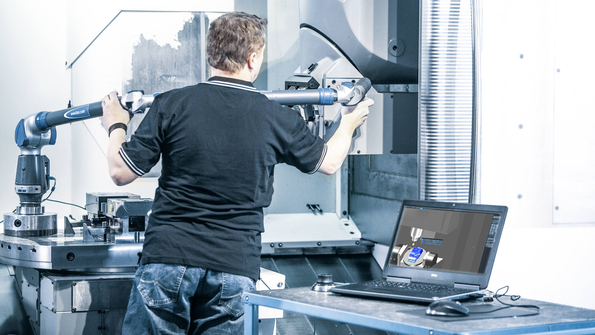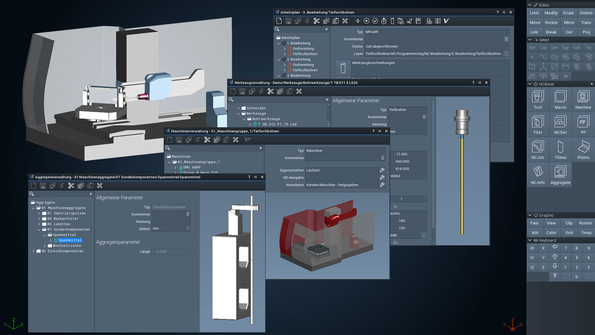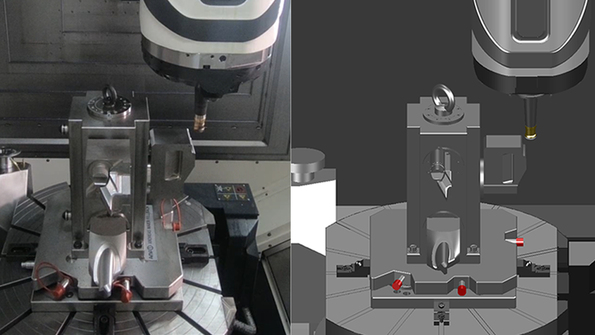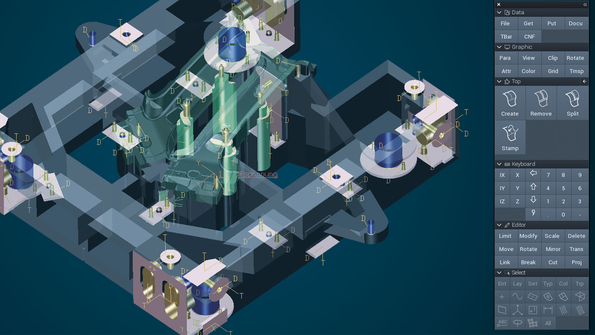Title
-
Software
-
CAM software
- Tebis Automill
- CNC programming
- CNC automation
- CNC simulator
- Multiple setup
- Robotic machining
- CNC drilling
- Deep-hole drilling
- Combined turn-milling
- CNC turning
- Turn-milling
- 2.5D milling
- 3D milling
- 5-axis milling
- Slot milling
- Trimming
- HPC milling
- HFC milling
- Circle-segment cutters
- Sinker EDM
- Wire EDM
- 3D laser cutting
- Laser hardening
- Laser weld cladding
- CAD software
- CAQ software
- MES software
- Products
-
CAM software
- Services
- Consulting
- Sectors
- References
- Company
- News
Contact

-

One CAM system to meet every need
High-quality results, automated processes, efficient work procedures and maximum safety in manufacturing – the demands on modern CAM systems are high. Constantly changing market requirements and technical innovations require continuous adaptation of the software. As market consolidation continues, that is not always a given. So what is a CAM system at present and what parts are important?
Many aspects of CAM software today influence efficiency, quality and safety in manufacturing. They come to bear in various steps of the process chain. Therefore, end-to-end capability is an essential characteristic of modern CAM solutions. In other words: A single software system should be able to cover as many work procedures as possible, from design (CAD) to manufacturing (CAM) and quality control (CAQ) – whether for manufacturing large parts, complex geometry or series.
It should also support as many different manufacturing technologies as possible, such as milling, turning, drilling, hardening and the latest machine kinematics with multiple axes as well as robots. With Tebis CAD/CAM software, users design 3D CAD models for a wide range of manufacturing areas and automatically calculate NC programs for their NC-controlled manufacturing and quality testing. That ensures that orders, from simple to highly complex parts, can always be completed on time.
End-to-end efficiency, high quality and reliability
This single-system strategy makes the manufacturing process more fluid, faster and more transparent. Benefits can be seen as early as the work preparation stage. Instead of working in the machine shop, the NC programmer works on a large monitor in a quiet office. As a result, the machines are always productive. In addition, errors are minimized because the information from the CAD model is sent directly through to the machine with no loss of precision. The machine operator receives clear instructions for setup and required tools – with no manual entries or paperwork. All data remains in a single system from the very start. This is efficient and less susceptible to errors and standardizes machine operation.
Digitalizing the manufacturing environment: Detailed virtual representations of elements such as machines, tools, clamping devices and units are integrated in the Tebis CAD/CAM system with their respective geometric and technical properties. This provides for greater reliability, standardization and automation in programming and manufacturing.Reliable manufacturing in a digitized environment with digitized knowledge
Many CAM systems make it possible to work with digital twins of tools. Modern solutions do even more: They know every detail of the company's manufacturing environment and have access to its unique manufacturing knowledge. This ensures greater reliability, standardization and automation in programming and manufacturing. System-specific libraries contain true-to-life digital representations of the machines, controls, tools, clamping devices and units with their respective geometric and technical properties.
The individual manufacturing knowledge is contained in templates and features. This gives every user access to proven methods after only a short training period. In automatic mode for related machining tasks, NC programmers select suitable machines in the virtual environment, define the optimal setup and select corresponding machining templates. A modern CAM system like Tebis then selects suitable and available tools and calculates collision-checked NC programs that are optimally matched to the manufacturing environment.Integrated simulation for maximum collision safety
CAM solutions with integrated simulation technology provide a high degree of safety. Such systems already offer a high degree of realism when defining the setup in the virtual machine environment. Users then check calculated NC programs in the virtual CAM environment. CAM systems with integrated NC program simulation detect possible collisions and limit switch problems when the NC paths are calculated and automatically avoid them, for instance, by reducing milling areas and using 5-axis avoidance.
Efficiently achieve high-quality CAD surfaces and Class A quality
Modern CAM systems lay the groundwork for high-quality parts and the corresponding degree of NC automation in the manufacturing design stage. Depending on the manufacturing technology, NC programmers use different CAD functions to prepare their manufacturing models for subsequent NC processes.
Of course, NC free-form surfaces can only be as good as the underlying CAD data. Good CAM software is therefore also characterized by powerful integrated functions for structuring, designing, repairing, morphing, scanning and reverse engineering.
For the quality of manufactured surfaces – especially for free-form geometry – it is also critical that the CAM system calculates the NC paths on mathematically exact surfaces instead of on tessellated substitute models such as polyhedrons. To avoid manual reworking, it should also be possible for the user to influence the finish quality with adjustable NC point distributions.
Modular and flexible in a single system
Manufacturing processes in the industry vary greatly from small and medium-sized manufacturers to the major players. A modular structure is therefore absolutely essential for a modern software solution. Users can get started at low cost and can grow flexibly to meet increasing requirements.
Tebis offers suitable software packages for typical CAD/CAM applications that can be expanded as design and manufacturing tasks grow. If specific add-ons are needed only occasionally, these components can be shared among users.
Open for interfaces and networking
Finally, networking of systems has become increasingly important in the context of digitalization, and modern CAM systems are increasingly offering it. Especially user-oriented solutions are characterized by their openness to other systems. Users should be able to exchange their CAD models with potential clients’ most important systems via interfaces without data loss. On import, the software should automatically break assemblies down into individual manufacturing files and also optimize surface quality.
Real-time connections to tool databases and software for order planning and control enable improvements in the logistical processes, yielding large gains in efficiency. For example, Tebis can be directly coupled with MES ProLeiS. In this integrated environment, manufacturing projects can be planned and controlled much better with data that are always current. In the highly deadline-oriented die and mold manufacturing industry, this enables companies to ensure that all machining operations and components are completed on time and that they deliver their products according to the deadline.
Reiner Schmid, Head of Product management, Tebis AG




